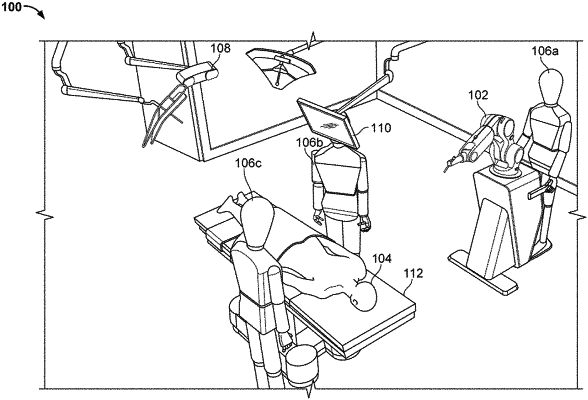| CPC A61B 34/20 (2016.02) [A61B 34/25 (2016.02); A61B 34/30 (2016.02); A61B 34/76 (2016.02); A61B 46/10 (2016.02); A61B 90/37 (2016.02); G02C 7/049 (2013.01); G06T 7/33 (2017.01); G06T 7/344 (2017.01); G06T 7/75 (2017.01); A61B 17/1615 (2013.01); A61B 17/1671 (2013.01); A61B 2017/00694 (2013.01); A61B 2017/00902 (2013.01); A61B 2034/104 (2016.02); A61B 2034/105 (2016.02); A61B 2034/107 (2016.02); A61B 2034/207 (2016.02); A61B 2034/2046 (2016.02); A61B 2034/2051 (2016.02); A61B 2034/2055 (2016.02); A61B 2034/2059 (2016.02); A61B 2034/2065 (2016.02); A61B 2034/2068 (2016.02); A61B 2034/252 (2016.02); A61B 2090/064 (2016.02); A61B 2090/065 (2016.02); A61B 2090/363 (2016.02); A61B 2090/364 (2016.02); A61B 2090/374 (2016.02); A61B 2090/376 (2016.02); A61B 2090/378 (2016.02); A61B 2090/3762 (2016.02); A61B 2090/3983 (2016.02); G02B 1/043 (2013.01); G02C 2202/16 (2013.01); G06T 2207/10016 (2013.01); G06T 2207/30012 (2013.01); G06T 2207/30196 (2013.01); G06T 2207/30204 (2013.01); G06T 2210/41 (2013.01)] | 5 Claims |

|
1. A method for registering a patient's anatomy with robotic surgical system having an instrument attached to an end-effector of a robotic arm of the robotic surgical system, the method comprising the steps of:
providing the robotic arm including an end-effector having an instrument attached thereto;
providing a force sensor attached directly or indirectly to the robotic arm; and
providing a processor and a memory having instructions stored thereon, wherein the instructions, when executed by the processor, cause the processor to:
receive haptic feedback, from the force sensor, prompted by movement of the instrument attached to the end-effector;
determine that the haptic feedback corresponds to contact of the instrument with a bone;
determine a set of spatial coordinates, wherein the set of spatial coordinates comprises a spatial coordinate for each contact of the instrument with the bone, expressed using a robot coordinate system, wherein each spatial coordinate corresponds to a point on the surface of an anatomical volume;
determine a set of medical image data coordinates expressed using a medical image data coordinate system that correspond to a patient anatomy surface;
map the surface corresponding to the set of spatial coordinates to the patient anatomy surface corresponding to the set of medical image data;
generate a coordinate mapping between the robot coordinate system and the medical image data coordinate system based on the mapping between the surface corresponding to the set of spatial coordinates and the surface corresponding to the set of medical image data coordinates;
modifying, by the processor, the set of medical image data coordinates that define the surface of the volume of the patient's anatomy with a set of interior medical image data coordinates such that a first volume defined by the set of medical image data coordinates is larger than a second volume defined by the modified set of medical image data coordinates; and
storing the coordinate mapping, thereby registering the patient's anatomy based on the determination of contact of the instrument with the bone.
|